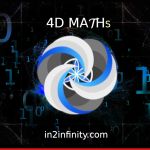Hello, and welcome to another broadcast from into infinity, where we’re talking about the PI solution, the Riemann hypothesis, and many of the other things that we’re coming out with as well. So today, I’d like to take the opportunity to talk about base infinity, partly because when I said base infinity, a lot of people got a little bit confused. What do I mean by base infinity? Is there such a thing? Actually, just to say is there such a thing as a little bit of a stranger thing because it is what you are experiencing everyday. Everyday and we are experiencing bass infinity in terms of what we call the reality construct. Let me put it like this. If you take a leaf from one tree and compare it to a leaf from the same tree, you will find those leaves will be completely different. At the same time, you’re able to take the leaf from another tree completely, and that you will never find a leaf that is identical. Yet you can say that some of those leaves give you a sort of structure that allows you to identify Yeah, it’s a leaf. And so what we’re really looking at then is like how close to the infinite does it need to get until it becomes apparent that it is a leaf? So let’s take the example let’s say I was really blurry eyed, and I took this leaf and I can’t see it very well. And it just looks like a blurry blob. And but as I bring the leaf if I’m able to sort of heal my eyes or put my glasses on, let’s say now the leaf takes on a more fine detail I’ve actually mentioned look closer at the leaf. And the more the closer I look at the leaf the more unique he is yet when I go down and pass the surface boundary and get down to the atomic level which is the fourth dimensional level. Suddenly it all just dissolves. And it’s all just a bunch of number code arranged in a kind of geometric pattern. Yeah, which is what the atom kind of is. So what the atom really is, is like the geometric code isn’t of the universe. And how we experience it is that infinity of number of base infinity. Now what happens is we tend to sort of look at this infinite stuff and we are able to draw out of that infinite stuff. A unit of things we can say, hey, that’s a, that’s a thing now, because we’re able to compare infinities that look similar. And we can do that as a collective that means that the nature of the infinite number space is not something which is just unique to myself. It’s a shared experience is what we call reality. You could imagine reality as being based on the on the infinities of the whole number. Whereas when we get the fractional sets, what we’re really looking at there is something completely different. We’re looking at numbers that don’t make sense. They completely don’t have any origin if you’d like. Yeah. And we’re still not sure how many numbers there are that don’t have any origin. But we can assume that there are some because actually we know that we have a structure of numbers within an infinite set, and where there’s a structure there’s an M structure. So we know that there’s there are things that are in that structure, but because we don’t really have a complete map of all infinite structures of all infinite numbers up to infinite dimension. We are still working on fourth dimension for example, then naturally, we do numbers beyond those dimensions start to get more complicated, particularly as you move into high dimensional space, because the laws of numbers start to change dramatically.
So working in base infinity, then is actually easier than actually working in base 10. Sometimes because we do it so naturally every day. And then we don’t need to count anything we just need to know it is that’s the kind of way it is. And so once you get whilst fourth dimensional mathematics might seem a little bit complicated at first, maybe there’s some different ways of thinking about things. That’s true, but actually, at its essence, it’s really tapping into the to how you are actually seeing and perceiving the world rather than as a numerical space. It’s actually the the space you’re seeing in front of your eyes. And so what we’re saying is there is a structure to space and that numerical structure is hidden in such a way that actually everything just appears to be uniform. Let’s take things like gravity, for example. Gravity is a uniform field, we know that we don’t know where it is, it’s hidden somewhere within that numerical space, you could say, where algebra has no effect. But what we say is that by looking at the real numbers underneath the stuff that makes the function that produces, you know, these numbers that we do the mathematics with, we can take a step down underneath the mathematic and performance to mathematical functions, but on numbers that are already reached an infinite. I have already been sort of a collection of an infinite set of all numbers that have devolved into that one number. And that’s one of the things we talk about when we talk about working in base infinity. What we’re saying is each one of these is not just a number, it’s an infinite. Yeah, so the number seven has an infinite version of itself. We’re adding all we can change the number and it will degrade into that same number. And any number that you put in from zero to infinity will still produce that same number. But when you go into the negatives, or when you go into the reciprocals, things start to change from Yeah, you just get off the negatives. But when you go into reciprocal space, it suddenly explodes. And you’re full of these crazy numbers that you didn’t know what to do with. But actually that’s, that’s part of the excitement of this mathematic is that you know, lots of crazy stuff starts happening. And so there is a there’s a structure the order actually is not as complicated as you might think. It just appears a bit strange at first. It’s actually to do with fractions and adding fractions to holes, but it’s not so complicated. But, but then we can also change the algorithms and that’s when it gets more complicated because infant algorithms you can see in mathematics, there’s lots of them. But what we have to look at then is the most simple ones, what do they do? And then try and make what we use the theory of effort to try and work out how in what order do these algorithms what order can they appear? Because if you start with a division, that’s the first algorithm. So once you’ve got something divided, you’ve already gone through that process. And then what happens after that, you know, well, we can add one we can minus one. Yeah. So we can do that. Yeah. So that’s where we came up with where we come up with the, the foundations of, of infinite mathematics. She’s like, you know, division divide plus one. And so, from that, you know, we can we can start to do other things we we even got into squaring too much but that squares the zero creates the pie. We can cubes go, zero to the power three is not a cube is actually a cross in space, a three dimensional crossing in infinite number space. As zero to the power of three is represented on the 2d plane as the Higgs diagonals. So actually, you know, fourth dimensional maths isn’t so complicated, and it’s actually easier than a lot of other mathematics because we often use geometry just to express it. So although there’s a lot of complicated mathematics when it comes down to the maths of infinity side of things, the which seems quite complex, but when you actually when you step out of the number zone, you know, the expression in geometry becomes something quite simple quite a lot of the time. And so actually, this becomes a very simple to understand kind of mathematic. However, there is complexity underneath as with all things use depends on deep you want to go and base infinity does imply that actually, you know, we’re trying to just we just have to work out the correction for the number line, but once you’ve done that, then we can be assured of what those those true values are based infinity. So we’ve done a lot of work on the PI just to unscramble the infinity the end, and that’s given us a nice solution has an ID, which has a root three solution which we need for the mazar e to the power of three. We call that the time circle, and then we have the root the root that just the the solution, which we decode the route to and which shows us the number 25, which can be viable, devolving pie, and so so we have kind of in device three, the golden ratio. So 25 devolves into Golden Ratio. It’s the what we call the end of the golden ratio. numbers go from five up to 25 510 1520 and 25 is the end of it, the fifth time scale. So that’s, that’s a pie of time. And then we got the square root of three, which is like it is is it’s kind of also the a little bit like a time a timeframe. You could say, yeah, it’s a collection of the ease. Yeah. So then we have the circle of space, if you like as well, but we get into more of that sort of stuff. Once once we get into the fourth dimensional mathematics of time space. But anyway I think you can base infinity is not as difficult as you might think. Just imagine all of the trees there are different than what every person looks different. You can identify them as who they are when you know them as John did. You so you can always define infant number of faces. So that’s not a problem your mind was made to absorb this base system of infinity. And really, the other thing is you don’t need you don’t need a large calculator to do a lot of the equations to start to be in to understand stuff. A lot of it is actually laid down in very simple numbers. We actually have a system of number from one to nine, which actually, you know, you can you can explain many, much much of the universal phenomena including quantum gravity solution. So actually, it’s very easy once you get into it. So don’t get put off by the fact that there’s, you know, based infinity sounds a little bit obtrusive, first, but once you get into the idea that you’re experiencing every day, and it can be expressed perfectly with the drawing compass, then you can understand mathematics and art do in fact, come together. Anyway, that’s a little bit on base infinity for now. And yeah, any other questions? Do feel free to ask us and we’ll see if we can answer them as soon as we can. Thank you very much. My name is Colin Powell. This has been into infinity broadcasting the point solution, and two, and we’re talking today about base infinity. Thank you very much.


